Here are three ways to safely update your old articles for SEO and keep your content fresh for readers.
from Brian Milners SEO Feed http://tracking.feedpress.it/link/13962/7570200
via IFTTT
I am really excited for the launch of my favorite search engine optimization academy ITTTT SEO V2
Here are three ways to safely update your old articles for SEO and keep your content fresh for readers.
may Google puke with FCS networker
Here are 14 technical SEO tips for e-commerce sites that you can use to improve your site this year.
Use Instagram to your advantage. These seven tactics can help power your e-commerce Instagram sales funnel to steady success.
may Google puke with FCS networker
Learn how you can gain maximum SEO value – and more – through content from industry veteran Loren Baker. Register for this webinar today!
the best old-school spam linking tool there is today
Are you using Shopify as your e-commerce platform? Learn common Shopify SEO issues and how to fix them.
the best old-school spam linking tool there is today
Here's how you can audit and gain insights from your keyword lists – the backbone of any SEO campaign.
may Google puke with FCS networker
Here's how aligning your SEO and content teams can help your brand achieve maximum marketing impact.
the best old-school spam linking tool there is today
Wondering how can you get custom, 100% white label SEO reports? Here's a software that can provide it to you.
the best old-school spam linking tool there is today
To survive, businesses constantly need to come up with new revenue streams.
While you may generate plenty of money by improving customer retention by focusing on your existing customers, you’re only getting a small piece of the pie.
The companies who focus on lead generation do more than just survive—they thrive.
That’s where I want you to be.
People don’t start a business to make the bare minimum.
As a marketing expert with a proven track record, I can help your company generate more leads with simple strategies.
Customers won’t find you unless you put some effort in making yourself visible.
Surprisingly, the majority of these tactics won’t be too much work for you and can be accomplished on a reasonable marketing budget.
You don’t always need to break the bank to get more customers.
Here’s how you can get started.
Look at how FabFitFun got a professional surfer and model Anastasia Ashley to post about their brand on Instagram:

FabFitFun sends their members a gift box every three months with a bunch of new products.
The box includes some beauty supplies, fashion items, and fitness gear.
Using Anastasia’s platform to promote their brand helps expose their company to a wider range of people.
Anastasia has over 1 million followers on Instagram.
That picture alone generated nearly 12,500 likes.
Let’s dissect the advertisement one step further.
Look at the caption. She included:
Anyone who sees this picture knows what steps to follow if they want more information.
It’s a great strategy for generating new leads.
Anastasia has more than twice the number of Instagram followers the company has.
It’s safe to say the majority of Anastasia’s followers weren’t even aware of this brand.
Employ the same strategy for your business.
Don’t think you’re obligated to use Instagram as the platform for this technique.
YouTube is another effective channel for influencer marketing.

Even though consumers may not know these influencers personally, they still feel a personal connection with them compared to a more well-known celebrity like a movie star.
Why?
These people may seem more approachable.
Interacting with your favorite television actor may seem unrealistic especially if they have millions of followers on different platforms.
But these lesser-known influencers are more relatable.
They don’t have personal drivers and red carpet access, so consumers are more willing to take their advice.
Find some brand ambassadors and social influencers to help your business generate new leads.
Facebook ads are a great way to gain exposure for your brand, which ultimately generates more leads.
But sometimes displaying your brand name alone with an advertisement isn’t enough.
You need to give your audience a reason to continue.
Make sure your Facebook ad has a call to action.
Let’s look at an example from AdEspresso:

I love this because, ironically, it’s a Facebook ad about Facebook ads.
I used this example because of the actionable CTA button: “Download.”
Getting a prospective customer to download a free ebook is a great way to generate new leads.
I like this strategy better than simply linking your Facebook advertisement directly to your homepage.
Anybody can do that, so be different and stand out from the crowd.
Facebook ads also let you customize your target audience, so you can generate leads by targeting the right people.
Take advantage of what Facebook for business has to offer:

When creating a campaign, select lead generation under the Consideration menu.
Facebook will even let you create a split test to see which advertising strategy gets better results.
This is something you should consider, especially if you’re debating between two different CTA buttons.
I like to use Facebook Ads because the platform allows you to completely customize your target audience.
Set parameters such as:
All of these help narrow your focus so you can generate leads from people who would be genuinely interested in your company.
For example, let’s take a look at a Facebook ad from Philips Norelco:

Their beard trimming products are obviously gender-specific.
But this advertisement focuses on men of a certain age and lifestyle.
It doesn’t belong on the newsfeed of a college female.
Make sure you fill in all the parameters when narrowing your audience to get the most accurate results and leads.
Twitter is another top resource for lead generation, but too many businesses overlook this method.
This is great news for you because you’ll have the chance to capture leads from your competition if you execute this strategy effectively.
There are two main steps to this tactic:
It’s that simple.
The advanced search query makes it easy for you to accomplish this.

There are four main categories of this search:
We’ll go through a hypothetical example to see how this works.
Let’s say your company sells sunscreen and sun tan lotion.
Words you might want to include in your search could be:
You can see where I’m going with this.
Include in your search relevant phrases too, such as “pool day” or “going to the beach.”
But what about the “none of these words” query?
If you include “sun burn” as two words, you may want to put a word like “razor” into the “none of these words” field so you don’t get search results for “razor burn.”
Does that make sense? It’s simple.
Now let’s move on to the People section.
You’re already getting notifications when people interact with you on Twitter, so there’s no reason to include your name in the search.
Instead, search for your competition.
As a sunscreen company, you could search for results that include Banana Boat:

You’ll see Twitter users who engaged with your competition.
Shortly, I’ll talk about what you can do with these users.
But for now, we’ll continue going through the search fields.
If you’re a local or regional company, narrow your search results to your area.
You don’t need to see what people are tweeting about in South Africa if your company doesn’t distribute products outside of Phoenix, Arizona.
For argument’s sake, let’s say your sunscreen company has an ecommerce platform with global distribution.
Should you omit the places field?
Absolutely not.
Enter locations where people need protection from the sun.
You also want to filter the date range.
If someone tweeted they got sunburn back in May 2013, that won’t help you generate leads today.
Narrow your search to the most recent results. The past week or month should be a good place to start.
Now that you’ve completed your search, it’s time to go through the results.
Reach out to users by replying directly to their tweets.
Favorite their tweets.
Follow their profiles.
These types of interactions will help increase your chances of getting more followers.

My favorite part of this strategy is that it won’t cost you anything, just your time.
Even if you’re paying a social media manager to do this job, it’s an efficient use of their time as well.
But unlike some of the strategies we looked at earlier, such as influencer marketing or Facebook ads, the Twitter advanced search query is free to use.
Through one avenue or another, let’s say a prospective customer manages to find themselves on your website.
If you used one of the strategies we looked at so far, I’m willing to bet you’re going to see an increase in website traffic.
But what happens from here?
You obviously don’t want them to just visit your website and leave.
Get some information from these visitors by having a strong value proposition.
Check out this example from Crazy Egg:

It’s a simple and accurate description of what the customer will get.
Your value proposition needs to be easy to follow and straight to the point.
Too many companies have a long and unnecessary “About Us” section on their homepages.
That goes for your company mission statement too.
Neither offers any value to the customer.
Now that you’ve explained why you’re better than the competition, you need to collect some information from the customer.

After you enter the website address you want analyzed, Crazy Egg will prompt you to create an account and enter your email address.
It’s an effective tactic for generating leads.
I know from firsthand experience because I’m the one who came up with this idea for Crazy Egg.
Once you have the person’s email address, you can continue to contact them with your existing email marketing strategies.
Blogs are a top way to increase website traffic and engagement.
They are also a great excuse for you to promote other content on your website.
If you can write SEO friendly blog posts, your website ranking will improve on Google’s search algorithm.
Now when someone is searching for something related to your brand, products, services, or industry, you could be a top hit.
You can also promote blogs across different social channels.
If you are struggling with finding content to post on your Facebook page or Twitter profile each day, you can post links to your blog posts so those social sites stay functional.
Your blog needs to be active.

If you’re struggling to find good writers or can’t put out blog posts frequently, consider looking for guest-bloggers.
It’s a win-win situation for both you and the guest blogger.
They will gain exposure to a new audience, and you’ll keep your content fresh.
In return, you can ask for this guest-poster to promote and link to your company on their blog.
You should also take advantage of guest-posting yourself.
Whenever other blogs related to your industry are looking for a guest post, jump on that invitation before someone else takes it.
Now you have the chance to do the same thing.
Your guest post will reach people who may not know your company even existed.
Blogging is one of my favorite strategies for generating new leads.
Yes, I am all about inbound marketing, but sometime cold outreach and prospecting is just as effective, if done right.
When I say cold outreach I mean highly targeted cold outreach, not the spray and pray type of grind.
This will allow you to fully personalize your outreach message, which will yield drastically higher ROI.
Here is how you can do it.
First, figure out your exact target prospects.
For example:
Once you figured out what your target prospect look like, head to LinkedIn to do some lead research with their Advanced Lead Search.
After you input the criteria, it’s time to reach out and start prospecting.
But, before you send anything, you need to ignite a first touch point.
You can do this by enabling email notifications for your target prospects inn LinkedIn’s Sales Navigator to get notified whenever they post on LinkedIn. Then you can reply and engage with their LinkedIn updates.
After you do about two to three of these engagements, add them as a connection and send out your first LinkedIn direct message.
In your message, make sure you personalize it by mentioning one of their updates that you engaged with. This will yield a high response rate, because you are not just some random guy messaging out of no where.
In addition, you should follow up with a direct personalized email.
To find your prospects’ email addresses I recommend using VoilaNorber. In addition, you can save loads of time with the chrome plugin Gmass, which allows you to automate your personalized emailing and follow ups.
Your business should always be looking for improvements.
While your existing customer base can help you pay the bills, continuing to grow and expand your company can help put some extra change in your pockets.
While some lead generation strategies will cost you money, you can use some inexpensive and free options as well.
Consider looking for influencers with a big social following to promote your brand.
You’ll have to pay them, but it shouldn’t be too costly.
It’s a great way to expose your brand to a new audience.
Facebook advertisements are a top way to make sure the ads are targeted.
Your company won’t be seen by just any random person.
Instead, you can choose your custom audience for your ad.
If you’re on a tight budget and don’t want to spend any money, use the Twitter advanced search query to generate leads.
Narrow your search options, and engage with relevant users.
Blogging is another free way to generate leads.
Look for any opportunities to guest-post as well.
Don’t forget to focus on your value proposition.
And last buy not least, give outbound prospecting a try.
What are some effective lead generation strategies you have tried?
the best old-school spam linking tool there is today
That latest post took days to develop.
It’s instructive and inspiring and educational and entertaining.
Easily, one of your best yet.
But you come to check your traffic data only to find that you’re ranking 70th in the SERPs.
In other words, you ain’t gettin no traffic anytime soon. Zip. Zilch. Nada.
Unless some crazy person is actually clicking seven pages deep on Google. Which they aren’t.
All of that hard work, research, and effort got you almost nothing in return.
Meanwhile, your competitors are ranking in the top ten results, even though their content isn’t as long or thorough.
Why? Because of Google.
But really, the most likely answer is time and links.
Your post is new, so it’s going to take some time.
Knowing this, that doesn’t mean you can sit around and expect it to be on the first page without doing work.
Thinking that your new post will gain thousands of links on its own is foolish.
Outperforming your competitors on search engines isn’t an easy, one-off task. But that doesn’t mean it’s impossible.
In fact, if you implement a few of these tactics, it’s likely that (in time) you will.
Why? Because your competitors are comfortable. They think the rankings won’t ever change.
You, on the other hand, are grinding to get ahead.
Here’s how you can outperform sites ranking above you on search engines.
When Google RankBrain was announced in 2015 on Bloomberg, it was made known that RankBrain was the third most important ranking factor.
But that was all they said.
What about the first and second ranking factors?
We got almost nothing for an entire year.
In 2016, we got some clear information (for once) from Google.
In a Q&A with Andrey Lipattsev, a Search Quality Senior Strategist at Google, we found out the two most important ranking factors:
Links and content. In no particular order of importance.
But that’s pretty much all we got.
It is something, though. It’s a start. And it was straight from the mouth of a high-level strategist.
It also makes sense when you look at recent studies and data sets.
For example, Backlinko recently analyzed one million search engine results pages and found that the top-ranking content had a significantly larger number of links:
The disparity between the #1 position and the #10 position is massive.
Meaning if you’re looking to take over the SERPs, you need links. You simply can’t rank high without them.
And according to Google, it’s one of the top two ranking factors. So ignoring it is not an option.
Don’t believe the data?
I don’t blame you. Healthy skepticism makes the world go round.
I didn’t at first either. But do a simple Google search for a desired keyword, and you’ll instantly see that it’s very true.
Searching for “SEO Guide” on Google will return this as the first result:
The next few results are from Kissmetrics and Search Engine Land:
So, let’s put this to the test. Open up Moz’s Open Site Explorer and toss the links in.
Start with the first post by Moz. Here’s what the backlink profile looks like:
Yes, that’s real. This post has over 23 freaking thousand links pointing to it.
That’s more than most people will get on their entire site in their entire career. By far.
Now plug in the second result from Kissmetrics and here’s what you see:
The results are pretty clear.
Both sites have incredibly high domain authorities and page authorities.
They’ve both been around for years and years.
The content is pretty similar. It’s in-depth, informative, and optimized for the user experience.
But one is outranking the other, and the most likely reason (according to Google) is simply that it has more links.
23,000 more. Meaning Google is being told over 23,000 more times how relevant and informative that content is.
So, what about content?
It’s the same thing. It’s about the numbers. Word count matters:
The longer the content, the higher chance it has to rank.
But not in the way that you think.
You know, the college essays where you inserted block quotes to add 500 words (yes, admit it, you did it too).
Yeah, that doesn’t work.
Word count for the sake of word count isn’t going to get you higher rankings.
That tactic died with keyword stuffing and will never return.
Long-form content wins on search engines because it’s designed to solve the entire user problem in one go.
Meaning that the content is designed to answer all questions, provide solutions, and then show the user how to fix it.
If your content accomplishes this, people won’t bounce back to Google to click on the next result.
To sum it up, links and content quality are the top two ranking factors.
If you want to outperform sites above you, focus on these two factors over anything else.
It’s just like a workout plan.
Want to lose weight? Don’t waste time doing isolation bicep curls.
Take the most effective route and target the top ways to accomplish your goal.
Here’s how to get more links and write better content to outrank your competitors.
Now that you know how important links are for rankings, you need more of them.

But not just any backlinks. Directory links won’t do it. Paying for low-level, spammy links from the dude who cold emailed you is a recipe for disaster.
Most people get caught up in the total quantity and forget to focus on quality too.
Quantity isn’t enough. Let me explain:
When a website (like a directory) links over and over to thousands of sites, Google starts to notice that these links are easy to acquire.
So Google puts less importance on them. Why? They’re easy to get!
So stop buying links. Stop spamming forums and Pinterest (what even is Pinterest??).
Backlinko data agrees with this notion, too:
The graph above essentially says that the top-ranking content has links from diverse websites.
Meaning you need many websites to link to you, not just one spamming your link over and over.
But that’s not all. You need links from high DA sites:
So the real recipe is:
Total amount of links + large amount of diverse sites + all high DA = rankings boost.
Take that, Gordon Ramsay!
Now that you know, how do you do it?
There are a few proven ways to get more high-quality links on your site.
One of the best is by creating round-up style content. This is content that mentions multiple popular influencers in your niche.
For example, check out this post from Bill Widmer that took the opinions of 30+ experts on their favorite marketing channels:
(That cool dude is me, by the way, in case you were wondering.)
But the point is, these types of posts get links.
I’ll prove it to you.
Here’s the backlink profile for this exact blog post:
Nearly 70 links to a single post that was recently uploaded. Pretty impressive.
And not just any links. Notice the top linking sites? They were all mentioned influencers in his post.
Getting the input of trusted influencers and showcasing them in your post is one of the best ways to get great links.
People are more likely to share it when you mention and show them in an informative light.
Getting the highest-quality links isn’t enough.
Remember that another top ranking factor is content.
Quality and frequency play a huge role in content that drives rankings.
According to HubSpot, companies that post more blog posts more often get more traffic:
And that’s not all. The more you blog, the more inbound leads you get:
Why? Because you’re effectively giving yourself more chances to rank higher on Google.
And when you rank higher on Google, you get more traffic.

If sites are ranking above you on search engines and you don’t have enough links to overtake them, post more often.
It’s one of the easiest ways to generate more traffic to compensate for a lower ranking.
The more often you post, the more indexed pages you have.
The more indexed pages, the more traffic.
Once you develop content, you can campaign for links to boost that content.
You can outperform sites with multiple approaches. It doesn’t always have to be outranking them for a single post.
Would you rather outrank them for one post or write five new ones that get more total traffic?
The answer is clear: more traffic.
Google has one goal in mind when it comes to their search engine (besides profit):
Creating the fastest, best user experience possible.
This is evident by conducting any Google search and seeing how quickly they deliver results:

They even tell you about it.
It’s a subtle brag.
But it tells us some instant data on how much they care about delivering content fast and effectively.
It’s their top priority because if they don’t, people will jump ship to Bing or Yahoo, or Ask Jeeves (wait, does that still exist?).
This has larger implications than just result delivery speed though.
When Google delivers results, they still want users to be satisfied.
If someone searches for “seo” and doesn’t click, but instead modifies their search for “seo guide,” Google takes note.
They understand that “seo” search results weren’t what they were looking for.
Similarly, if someone finds your post on Google but bounces fast and clicks on the next, Google notices.
They notice that your content isn’t solving user problems. And if it’s not, you can kiss those rankings goodbye.
So, what does this mean for SEOs and optimizing content?
It means you’ve gotta stop worrying about how search engines view your content and start caring about the user experience.
That means putting real emotion into your writing to trigger a response.
Or telling a story that people can’t resist reading.
Keywords are great, but stuffing “seo guide best 2017 content” into your title makes you look stupid.
Trust me – I’ve been there.
A searcher and reader are going to take one look at that title and never come back.
A great way to optimize your content for a real user is by taking advantage of Google’s free data mining.
It’s easy.
What’s the next blog post you want to write about?
For example, let’s say it’s about content marketing.
Conduct a simple Google search for that basic term and scroll to the bottom of the page:
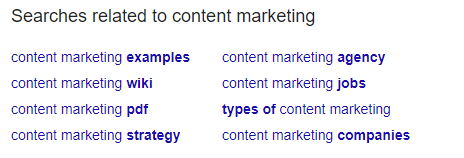
You’ve got instant, real keywords that people are searching.
You could easily compile several of these into a single long-form piece of content that is a one-stop-shop when it comes to solving a problem.
For example, write a content marketing strategy guide and include examples and types of content marketing.
Now you’ve effectively hit three real searches with a single post. That’s relevancy.
If you want to outrank the sites above you, you’ve gotta improve your content.
It has to be tailored to fit the user, not the search engine.
Search engines are getting smarter and more realistic. Rankings will follow if you focus on real people.
When you’ve written a new blog post, you can’t risk it slipping into the oblivion of the SERPs.
Anything beyond the first page isn’t going to get you any noticeable traffic.
And you can’t just expect a post to generate traffic and links on its own.
You’ve gotta put in the work to get real results.
If you want to outrank your competition, you need better links, real keywords, and better content.
Plain and simple:
You need to produce better content for the end user than the person above you.
Once you’ve done that, campaign for links.
The more high-quality links you land, the better shot you’ve got at ranking higher.
Outperforming sites ranking above you in the SERPs will drive more traffic to your site fast.
Kissmetrics combines behavioral analytics with email automation. Our software tracks actions of your users across multiple devices allowing you to analyze, segment and engage your customers with automatic, behavior-based emails in one place. We call it Customer Engagement Automation. Get, keep and grow more customers with Kissmetrics.
About the Author: Brad Smith is the founder of Codeless, a B2B content creation company. Frequent contributor to Kissmetrics, Unbounce, WordStream, AdEspresso, Search Engine Journal, Autopilot, and more.
the best old-school spam linking tool there is today
I see people make this mistake all the time.
They come up with a slogan and assume it’s an effective value proposition.
Yes, slogans are a great way to build your personal brand.
It’s a great way to help consumers remember who you are.
But slogans are not value propositions.
What’s a value proposition?
It’s a unique message to the consumer that conveys the main reason why they should buy from your brand.
Your value needs to be relevant to the customer. Explain why your brand, product, or service can offer a solution to a problem.
Be specific when you’re talking about these benefits.
Differentiate yourself from the field.
Why should your target customers buy from you instead of your competitors?
Overall, this message needs to attract customers by creating value.

Keep these five types of value in mind while you’re coming up with a unique proposition:
If you’re looking to improve your current value proposition or build one from scratch, I can help.
I’ll tell you everything you need to know about creating a highly effective value proposition.
Your value proposition should not appeal to everyone and anyone.
You won’t be able to please everyone, so don’t try to.
Trying to reach a wider audience with your value proposition could potentially backfire.
It could end up turning people away.
Here’s an example from Dollar Shave Club:

Look at the wording and terminology they are using in this value proposition.
I pointed out a couple of key points.
It’s clear they are trying to appeal to a younger audience.
Older generations may not understand the “level 9 yogi” analogy of their flexible cancellation plan.
The same people may not respond well to something as informal and direct as “C’mon. Do it.”
But Dollar Shave Club clearly defined their target market.
Changing their value proposition to something more basic could turn off their existing customer base.
Why?
People could see a generic pitch as boring or not as cool.
This company handles their value proposition really well in terms of focusing on a specific audience.
What added value can you provide?
It may sound like something small, but it could make or break the customer’s decision to buy something from you or a competitor.
If you offer added value, show it off.
Here are some examples:
Don’t wait until the checkout page to tell customers about these benefits.
If you don’t put it on your homepage, they may never even get to your conversion page.
Look at how Bed Bath & Beyond accomplishes this on their website:
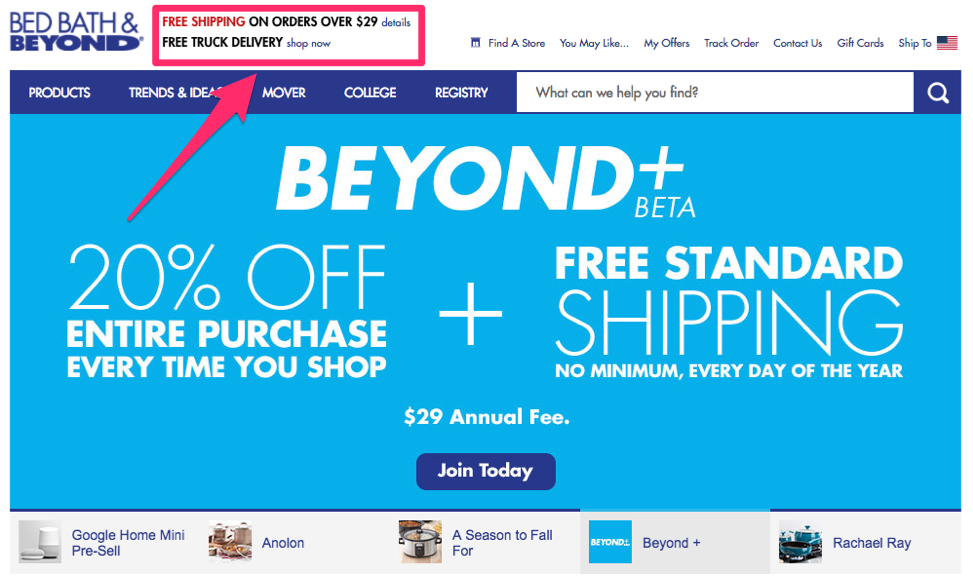
The website visitors instantly see two pieces of added value:
Now they know they can get their order shipped free even if they are buying furniture.
It can entice them to add something big, like a couch or a table, to their shopping carts.
According to Marketing Land, free shipping is the top incentive for consumers who shop online.

This is an essential piece of information to anyone in the ecommerce industry.
Why?
Because it’s something that adds value to the customer.
There’s no perfect way to display your proposition.
It’s not like there’s a blueprint that has specific requirements.
With that said, there are certain components you should consider when coming up with this display on your website.
Start with a headline.
Keep it short, and try to grab the customer’s attention.
Next, create a subheader.
It will be slightly longer than your headline, adding a little bit more information.
The subheader should be specific.
You’ll also want to come up with a few sentences that describe your brand, product, or services in greater detail.
It’s always helpful to include some bullet points that outline some of your top benefits or key features.
Images work well too.
Visuals help make the customer understand exactly what you’re offering or how the product works.
Let’s take a look at the value proposition from Square:
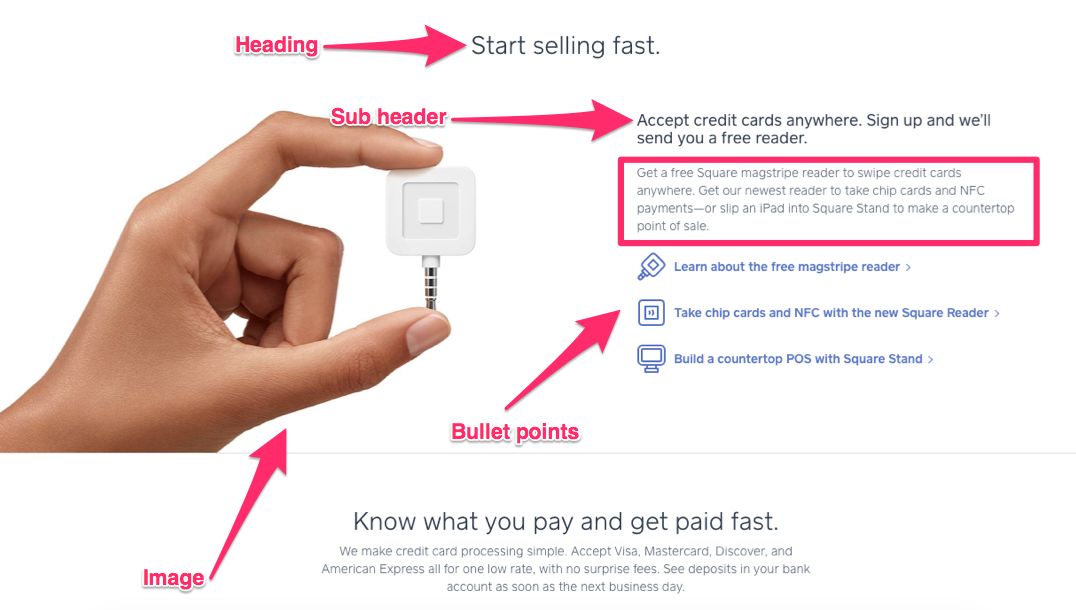
I love this homepage because it encompasses everything we just discussed.
The header instantly grabs the attention of prospective customers.
What exactly does the company do?
The sub header explains that you can “accept credit cards anywhere,” and the brief description goes into greater detail about how it works.
Square also included bullet points with their top features:
What does the product look like?
The image shows exactly what they’re offering.
Showing scale implies more added value as well. It’s so small that it can fit into your pocket.
If you’re struggling to come up with a layout for your company’s value proposition on a website, you can treat Square’s site as a template.
Just swap out their benefits and description for your own.
But what if you don’t know your top benefits?
If that’s the case, it sounds like you have a marketing problem or a possible issue with your company’s identification.
It’s fixable if you’re willing to put in some research.
Think back to what we outlined earlier.
Start with your target audience.
Conduct a study.
Here’s an example of some critical consumer research in the IT industry in relation to the value proposition.

If you’re in the IT field, you should focus your proposition on:
That’s just one example.
It’s up to you to conduct research based on your company and industry.
Reach out to your customers directly and ask what they’re looking for.
Create online surveys. Conduct customer interviews.
This will help you accomplish a couple of things at the same time:
Essentially, you’re killing two birds with one stone.
Now that you’ve developed a value proposition, it’s time to make sure you have it optimized to maximize conversions.
A/B testing is one of the best ways to do this.
Make sure you test only one thing at a time.
If you change too much, you won’t know which aspect of the test increased or decreased conversions.
Here’s an example from California Closets:

At first glance, these website versions appear identical.
The only thing changed was the heading.
Split-testing your website to find out which part of the value proposition is more effective will increase your conversion rates.
After you test the header, test something else.
In the example above, they could test the background image next.
They could also add more bullet points or put the bullets on another part of the screen.
The options are endless.
Another way to test your value proposition is through pay per click (PPC) advertising campaigns.
For the most part, we’ve been discussing your value proposition in relation to your website.
But that’s not the only place where you’re trying to acquire customers and get conversions.
It makes sense to have an effective value proposition on other platforms as well.
Consider using Facebook’s PPC services.
It just depends on how much you’re willing to spend.
The placement of your advertisement will impact the price.

Back in 2012, Facebook acquired Instagram for $1 billion dollars.
If you want to run a PPC campaign on Instagram, you have to go through Facebook.
This will be one of the most expensive ways to test your value proposition through PPC advertising.
However, if you have the funds, you could get the most accurate results with this method.
But don’t feel obligated to use Instagram.
Facebook offers other, more affordable, placement options.
If you’d like to avoid Facebook and social platforms altogether, you’ve got other options.
Consider running your PPC testing through Google AdWords.
You can test your value proposition at a local level or internationally.
Google lets you set this up by:
Less than half of small businesses are currently investing in PPC advertising.

Even if your business is small, you can still take advantage of this strategy.
It will give you an edge over your competitors.
The emotional value was something we briefly discussed earlier.
I want to elaborate on this because I think it’s important.
Triggering an emotion in your value proposition can elicit a certain response from your customers.
In your case, obviously, you want this response to be a sale or conversion.
Take a look at how different industries are rated based on emotional responses:
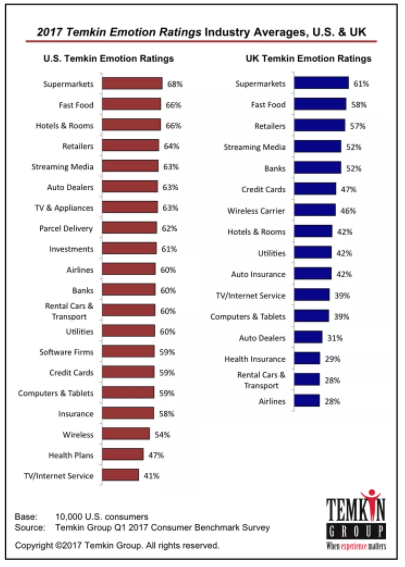
How can you elicit certain feelings from your customers?
Think about the goals and mission of your company.
Your value proposition should portray what your business represents.
Here’s an example from Mercedes-Benz:
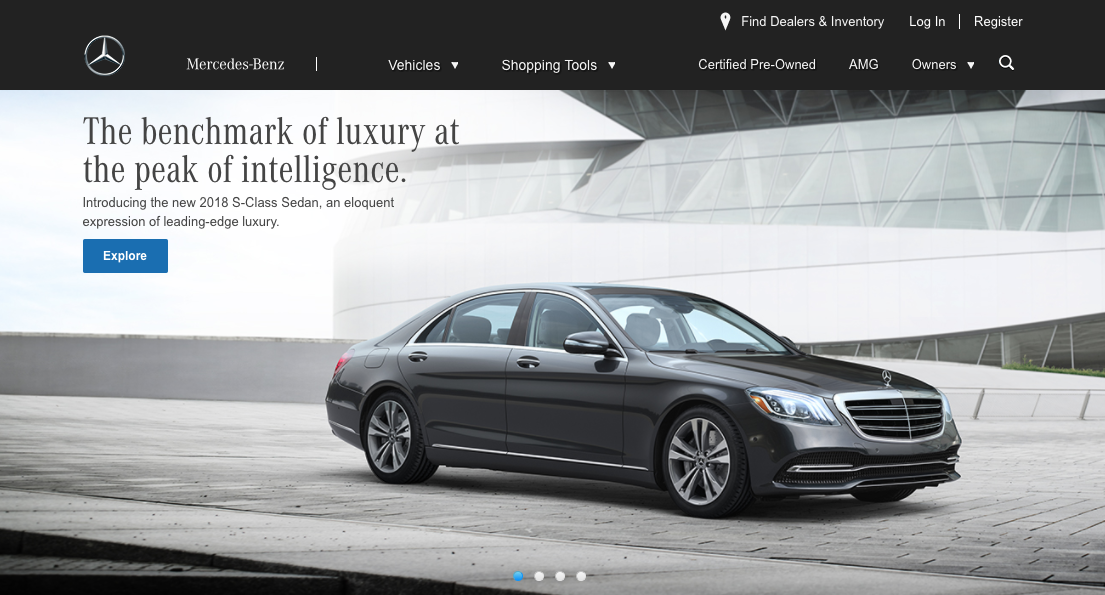
Look at the phrases they are using in the top left corner:
It’s clear what kind of emotions they are trying to elicit.
They used the word luxury twice, so they’re targeting people who want to have a very specific experience.
Symbolism.
This car portrays a certain level of social status.
That’s how they have effectively branded their company.
Let’s take a look at another example that’s on the opposite end of this spectrum.
We’ll discuss a company involved with charitable organizations.
Have you heard of Project 7?
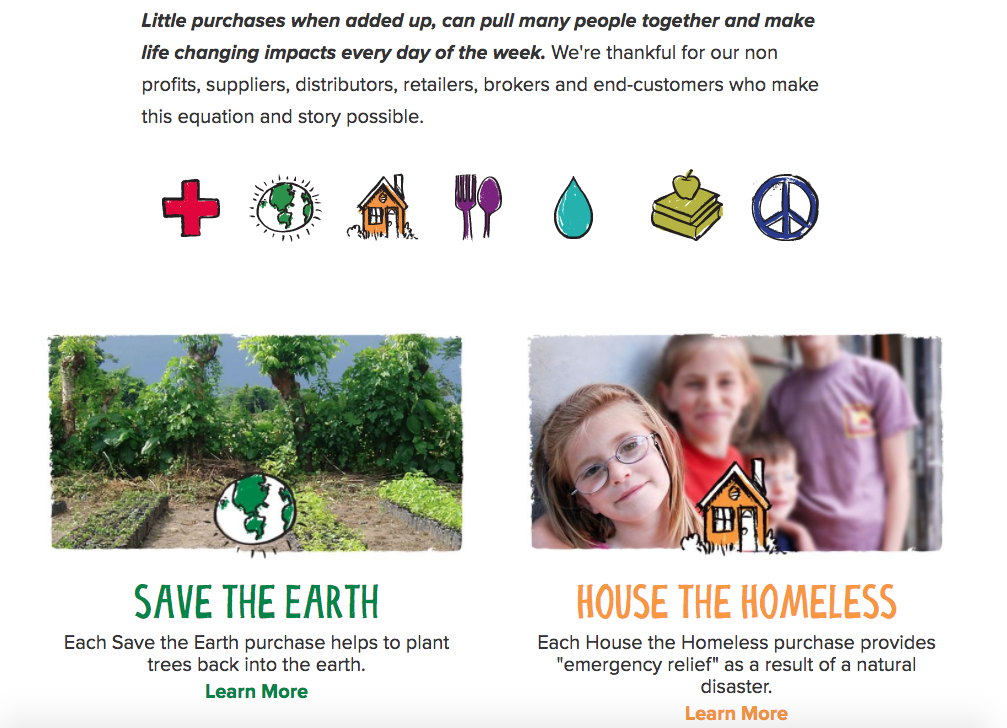
They sell gum and mints.
A portion of their sales goes to nonprofit businesses, suppliers, and distributors who help people in need.
The money goes to 7 different missions:
Businesses that give back to the community both locally and internationally should be proud of what they’re accomplishing.
Share that information with your customers in your value proposition.
It can trigger an emotional response leading to a sale.
If your company has a catchy slogan, that’s great.
But your slogan is not the same thing as a value proposition.
Your value proposition should talk about the functionality of your brand, products, or services.
What differentiates your company from the competition?
Your value proposition won’t appeal to everyone.
Don’t worry—it doesn’t have to.
Focus on your target market.
Mention any added value as well.
Even if it’s something small like free shipping, free installation, or a money back guarantee, it could be the deciding factor that drives a sale.
Learn how to present your value proposition:
After you build an initial value proposition, test it.
I recommend using A/B testing and PPC advertising to find the best option for your layout.
What does your company stand for? Use this to generate an emotional response from your customers.
If you follow these tips, you can create a highly effective value proposition.
What added value does your business offer to differentiate itself from the competition?
how I went to number one on Google for a competitive term by just getting people to click my page